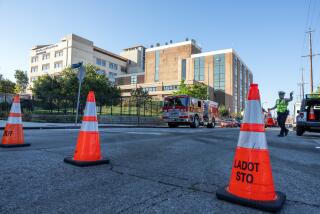Hospital error leads to 206 radiation overdoses
Scores of radiation overdoses at Cedars-Sinai Medical Center have been traced to a single cause: a mistake the hospital made resetting a CT scanner.
Hospital officials said Monday that the error occurred in February 2008, when the hospital began using a new protocol for a specialized type of scan used to diagnose strokes. Doctors believed it would provide them more useful data to analyze disruptions in the flow of blood to brain tissue.
That meant resetting the machine to override the pre-programmed instructions that came with the scanner when it was installed.
“There was a misunderstanding about an embedded default setting applied by the machine . . . ,” officials at the renowned Los Angeles hospital said in a written statement that provided no other details about how the error occurred. “As a result, the use of this protocol resulted in a higher than expected amount of radiation.”
The dose of radiation was eight times what it should have been.
Once the scanner was programmed with the new instructions, the higher dose was essentially locked in. Each patient who got the procedure -- known as a CT brain perfusion scan -- was subjected to the overdose.
The machine was used for other types of scans but the reset error affected only the potential stroke patients, said Richard Elbaum, a hospital spokesman.
The error went unnoticed for the next 18 months, until this August, when a stroke patient informed the hospital that he had begun losing his hair after a scan.
When the hospital reviewed its records, it found -- and contacted -- 206 people who had received the overdoses to inform them of the mistake. Only then, Elbaum said, did the hospital learn that about 40% of them had suffered patchy hair loss. Many also experienced reddening of the skin.
A CT scan uses a series of X-rays to create a highly detailed image. Possible stroke victims are injected with an iodine solution, which appears in the scans and is used to track blood flow in the brain.
Even under normal circumstances, the procedure requires more radiation than most other types of CT scans, said David Brenner, director of radiological research at Columbia University Medical Center in New York.
Excess radiation would be difficult to detect from simply looking at the scan results, he said. More radiation simply produces a clearer image.
Radiation exposure increases the likelihood of cancer, though the risk is lower in older patients because they are likely to die of other causes first. The median age of the patients who received the overdose is 70, said Elbaum, the Cedars-Sinai spokesman.
The discovery of the overdoses prompted the Food and Drug Administration to issue an alert last week warning hospitals across the country to check their CT protocols.
The hospital has received calls from other “advanced hospitals” that now are reviewing their own safety procedures, according to the statement.
General Electric, the manufacturer of the scanner, released its own statement Monday saying there were “no malfunctions or defects” of the machine.
It said that any new scanning protocol should be carefully evaluated “against the validated protocols that are provided on the scanners during installation.”
Experts on medical radiation said it is not uncommon for radiologists to override the pre-programmed instructions -- most commonly when the doctors believe they can glean the necessary information using less radiation.
Dr. Thomas Dehn, a radiologist and chief medical officer for National Imaging Associates Inc., which manages health plans for private insurers, said he believes that overrides are more likely to occur at large, state-of-the-art hospitals.
“At a small hospital, you are not going to try and out-think GE,” he said.
“You have to be pretty confident to think you know more than the guys who designed the equipment.”
--
More to Read
Sign up for Essential California
The most important California stories and recommendations in your inbox every morning.
You may occasionally receive promotional content from the Los Angeles Times.











